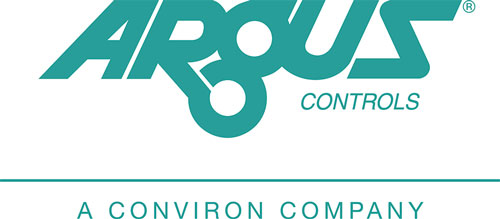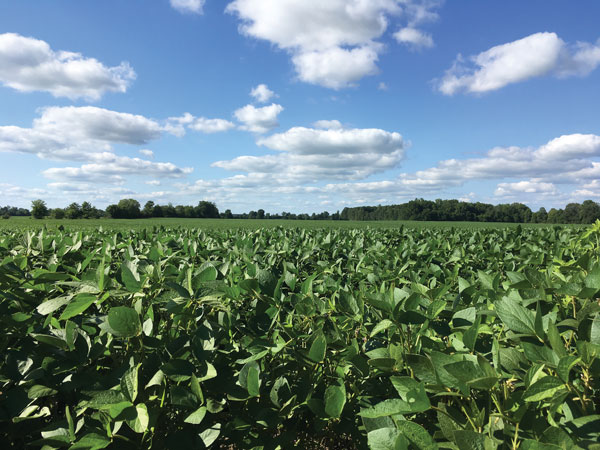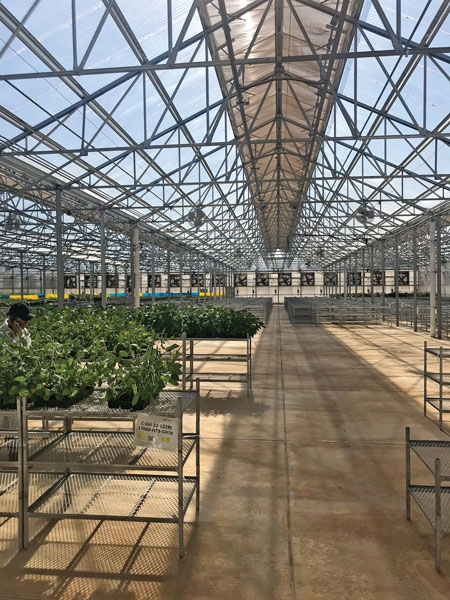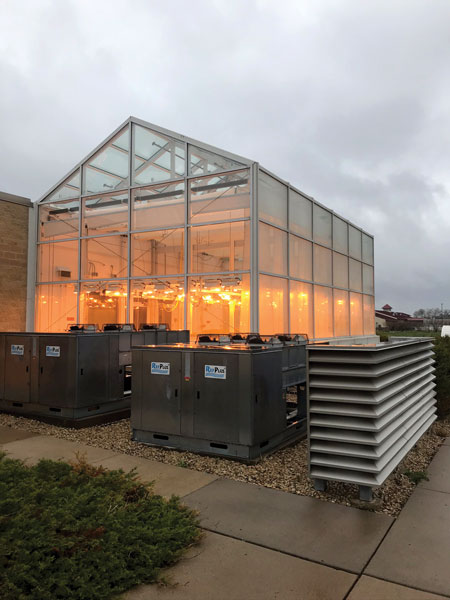6/1/2020
Light Control in Greenhouses
Alex Fermon

Adapted from “Light and lighting control in greenhouses” by Argus Controls.
Although the sun’s spectral quality is constant, it’s highly variable in intensity, duration (daily and seasonal) and direction. Many strategies, including shading and supplemental illumination systems, have been developed to deal with the undesirable indoor production conditions associated with light fluctuation.
Sunlight conditions in greenhouses can vary rapidly, affecting temperature, humidity and illuminance. To compensate, greenhouse ventilation, heating, shading, irrigation, humidification and lighting equipment must be reasonably responsive to these fluctuations if a controlled growing environment is to be achieved. This requires good engineering and the proper selection of equipment and control devices. It also requires an understanding of the capabilities and limitations of the greenhouse equipment systems, sensors and controllers.
 Pictured: Sunlight provides a natural source of light in the greenhouse.
Pictured: Sunlight provides a natural source of light in the greenhouse.
Most integrated environmental control equipment can make nearly instantaneous adjustments to equipment in response to changing sensor information, predictive algorithms and programmed logic responses. In general, automated controllers are far faster at telling the equipment components what state they should be in than the equipment can respond. Even if the equipment could respond instantly it would seldom be beneficial to do so since excessive on/off cycles can limit the life of motors, switch gears and light fixtures. Properly tuned integrated climate control systems respond to changes in the environment in a dampened or attenuated fashion that strikes a balance between the need to maintain set points and the need not to overtax equipment nor overshoot the degree of response.
Control over how much light a greenhouse crop receives can be influenced by two principle methods: shading and supplementary illumination.
Shading control
For full-sun tolerant crops—such as tomatoes, cucumbers and chrysanthemums—shading is never required to limit PAR levels. Properly acclimatized, these crops are perfectly capable of withstanding and utilizing the full power of the sun. However, there’s often a need to provide shade as a means of limiting heat buildup in the greenhouse air and on leaf surfaces. Also, some internal shade systems, if carefully used, can be partially effective in helping to lower vapor pressure deficit on bright, hot days. For low-light crops, and special applications such as rooting cuttings, shade is used as a necessary means of limiting total solar radiation.
External shading has the advantage of absorbing and reflecting light energy before it enters the enclosed greenhouse, heating the air and all enclosed objects. The disadvantages of external shade methods are that the coatings are semi-permanent (they must be washed away) and externally mounted retractable screens are expensive to construct and maintain due to wind and weather considerations.
 Pictured: Shading control in the greenhouse.
Pictured: Shading control in the greenhouse.
Internal screen systems are effective in reducing the light levels falling onto plant surfaces, but they do little to limit heat buildup within the greenhouse enclosure. However, since much of the light energy conversion to heat takes place above the screens, it can quickly be exchanged with cooler outside air in greenhouses that are roof ventilated. Although some heat accumulation occurs under the screens as well (in inverse proportion to the percentage of shade), the warmed air can rise through the screens if they’re sufficiently porous or, in the case where nonporous screens are used, gaps must be left to allow for roof-vented air exchange.
Nonporous screens can be completely closed when sidewall ventilation is used under them. When motorized retractable shade screens are used, it’s possible to automate their deployment. Some typical control parameters that can be used to operate shading equipment include:
• Time (absolute or relative to daylength and season)
• Global light (from outdoor sensors)
• Temperature (outdoor and/or indoor)
• Humidity (set points)
• Photoperiod programming (for blackout screens)
Other parameters that may be used to control the behavior of shading devices include staged opening and closing strategies, special overrides for events such as snowfall, spraying operations, and synchronization with heating, venting, humidity control and CO2 supplementation. The most flexible control programs allow for the integration of several parameters at once.
 Pictured: Supplemental illumination in the greenhouse.
Pictured: Supplemental illumination in the greenhouse.
Most curtain systems are relatively slow to fully close or open. This lag time can be a problem for sensitive crops that could be damaged if exposed for even a few minutes to bright sunlight. If the sun suddenly appears from behind dark clouds, it may take several minutes for the curtains to fully close. In these cases, it’s better not to rely upon shade curtains alone for protection. Fixed screens, overhead mist or sprinkler systems timed for such events, or an application of shading compound on the roof, may provide an additional safety margin. When curtains are used for energy conservation, it’s possible for cold air to accumulate between them and the greenhouse roof during cold weather. At such times, it’s best to gradually stage their curtain opening to reduce the shock of cold air spilling onto the crop.
Supplemental illumination control
Lighting systems can be operated automatically using simple time clocks or sophisticated integrated controllers. Some greenhouses with large installations may not have enough electrical service to operate all of their lights at the same time, so they may need to be staged in accordance with available electrical power. When integrated controllers are used, it’s possible to control the operation of supplemental light systems by a few parameters including:
Time
• Cyclical lighting (for photoperiod control)
• Supplemental lighting duration control
Light
• Integrated daily light levels (DLI)
• Instantaneous radiation set points
CO2 synchronization
Cyclical lighting is normally only used with incandescent lamps only to provide photoperiod control by cycling a series of relatively short duration lighting periods in the night. By using this method, it’s possible to use less overall illumination time and electricity consumption than with conventional long-day illumination. It’s not recommended for use with HID lighting, since these luminaires aren’t designed for frequent cycling.
Lighting control
For supplemental lighting, regardless of the control method, it’s best to operate the lights for extended periods, since short cycling of these luminaires will greatly reduce the lamp and ballast life. Therefore, when setting up programs based on available instantaneous or accumulated light energy, it’s best to set up some conditions that prevent cycling.
These can include a proving time, where the need for either turning the lights on or off must be sustained for a desired period. This prevents the lights from cycling on and off in partially cloudy weather. Another method of preventing cycling when using light-based control is to provide for a minimum on and off time override.
Other additional strategies could be used alone or in conjunction with the above. For instance, to get the maximum value from CO2 supplementation, it’s necessary to have adequate light levels. A separate program could be set up to ensure that crops always receive a minimum light level during CO2 supplementation periods. GT
Alex Fermon is Marketing Coordinator for Argus Control Systems.